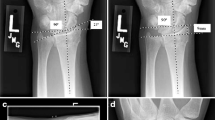Abstract
To tests the hypothesis that classification and characterization of fractures of the radial head is more accurate with 3D than 2D computed tomography images and radiographs, using a prospective study design with intraoperative inspection as the reference standard. Treating surgeons and first assistants completed a questionnaire assigning a fracture type according to the Broberg and Morrey modification of Mason’s classification, evaluating selected fracture characteristics, and electing preferred management based upon radiographs and 2D images alone; then adding 3D-CT; then 3D printed physical models; and finally intra-operative visualization. The addition of the 3D CT and physical models improved the sensitivity for fracture line separating the entire head from the neck, comminution of the radial neck, fracture involving the articular surface, articular fracture gap greater than 2 mm, impacted fracture fragments, greater than 3 articular fragments, and articular fragments judged too small to repair. There were no significant differences in diagnostic performance with the addition of 3D models. The addition of 3D CT and models improved the reliability of Broberg and Morrey classification. We conclude that 3DCT and 3D physical modeling provide more accurate fracture classification and characterization of fracture of the radial head with less proposed variability in treatment. We did not demonstrate a clear advantage for modeling over 3DCT reconstructions.
Level of Evidence: Diagnostic, Level I



Similar content being viewed by others
References
Borrelli J Jr, Goldfarb C, Catalano L, Evanoff BA (2002) Assessment of articular fragment displacement in acetabular fractures: a comparison of computerized tomography and plain radiographs. J Orthop Trauma 16(7):449–456, discussion 56–7
Castagno AA, Shuman WP, Kilcoyne RF, Haynor DR, Morris ME, Matsen FA (1987) Complex fractures of the proximal humerus: role of CT in treatment. Radiology 165(3):759–762
Edelson G, Kelly I, Vigder F, Reis ND (2004) A three-dimensional classification for fractures of the proximal humerus. J Bone Joint Surg Br 86(3):413–425
Katz MA, Beredjiklian PK, Bozentka DJ, Steinberg DR (2001) Computed tomography scanning of intra-articular distal radius fractures: does it influence treatment? J Hand Surg [Am] 26(3):415–421
Kilcoyne RF, Shuman WP, Matsen FA 3rd, Morris M, Rockwood CA (1990) The Neer classification of displaced proximal humeral fractures: spectrum of findings on plain radiographs and CT scans. AJR Am J Roentgenol 154(5):1029–1033
Kuhlman JE, Fishman EK, Ney DR, Magid D (1989) Two-and three-dimensional imaging of the painful shoulder. Orthop Rev 18(11):1201–1208
Siebenrock KA, Gerber C (1993) The reproducibility of classification of fractures of the proximal end of the humerus. J Bone Joint Surg Am 75(12):1751–1755
Smith RM (2000) The classification of fractures. J Bone Joint Surg Br 82(5):625–626
Lindenhovius A, Karanicolas PJ, Bhandari M, van Dijk N, Ring D (2009) Interobserver reliability of coronoid fracture classification: two-dimensional versus three-dimensional computed tomography. J Hand Surg [Am] 34(9):1640–1646
Jupiter JB, Ruder J, Roth DA (1992) Computer-generated bone models in the planning of osteotomy of multidirectional distal radius malunions. J Hand Surg [Am] 17(3):406–415
Murase T, Oka K, Moritomo H, Goto A, Yoshikawa H, Sugamoto K (2008) Three-dimensional corrective osteotomy of malunited fractures of the upper extremity with use of a computer simulation system. J Bone Joint Surg Am 90(11):2375–2389
Broberg MA, Morrey BF (1987) Results of treatment of fracture-dislocations of the elbow. Clin Orthop Relat Res 216:109–119
Landis JR, Koch GG (1977) The measurement of observer agreement for categorical data. Biometrics 33(1):159–174
Harrell F (2001) Regression modeling strategies with applications to linear models, logistic regression, and survival analysis. Springer, New York, pp 331–342
Kocher MS, Zurakowski D (2004) Clinical epidemiology and biostatistics: a primer for orthopaedic surgeons. J Bone Joint Surg Am 86-A(3):607–620
Doornberg J, Lindenhovius A, Kloen P, van Dijk CN, Zurakowski D, Ring D (2006) Two and three-dimensional computed tomography for the classification and management of distal humeral fractures. Evaluation of reliability and diagnostic accuracy. J Bone Joint Surg Am 88(8):1795–1801
Harness NG, Ring D, Zurakowski D, Harris GJ, Jupiter JB (2006) The influence of three-dimensional computed tomography reconstructions on the characterization and treatment of distal radial fractures. J Bone Joint Surg Am 88(6):1315–1323
Guitton TG, Ring D, Science of Variation Group (2011) Interobserver reliability of radial head fracture classification: two-dimensional compared with three-dimensional CT. J Bone Joint Surg Am 93(21):2015–2021
Rosset A, Spadola L, Ratib O (2004) OsiriX: An Open-Source Software for Navigating in Multidimensional DICOM Images. Journal of Digital Imaging 17(3):205–16
Doornberg J, Elsner A, Kloen P, Marti RK, van Dijk CN, Ring D (2007) Apparently isolated partial articular fractures of the radial head: prevalence and reliability of radiographically diagnosed displacement. J Should Elbow Surg 16(5):603–608
Matsunaga FT, Tamaoki MJ, Cordeiro EF, Uehara A, Ikawa MH, Matsumoto MH et al (2009) Are classifications of proximal radius fractures reproducible? BMC Musculoskelet Disord 10:120
Morgan SJ, Groshen SL, Itamura JM, Shankwiler J, Brien WW, Kuschner SH (1997) Reliability evaluation of classifying radial head fractures by the system of Mason. Bull Hosp Jt Dis 56(2):95–98
Sheps DM, Kiefer KR, Boorman RS, Donaghy J, Lalani A, Walker R et al (2009) The interobserver reliability of classification systems for radial head fractures: the Hotchkiss modification of the Mason classification and the AO classification systems. Can J Surg 52(4):277–282
Disclaimer
Research Specific Grants: Stryker; Biomet
Honoraria/Travel: AO North America, AO International
Consultant: Wright Medical, Skeletal Dynamics, Biomet
Royalties: Wright Medical; Skeletal Dynamics; Biomet
Stock Options: Illuminos, Inc
IRB: The Massachusetts General Hospital IRB has approved the human protocol for this investigation under number 2006-P-000869/16.
Author information
Authors and Affiliations
Corresponding author
Electronic supplementary material
Below is the link to the electronic supplementary material.
ESM 1
(DOC 1110 kb)
Rights and permissions
About this article
Cite this article
Guitton, T.G., Brouwer, K., Lindenhovius, A.L.C. et al. Diagnostic Accuracy of Two-Dimensional and Three-Dimensional Imaging and Modeling of Radial Head Fractures. J Hand Microsurg 6, 13–17 (2014). https://doi.org/10.1007/s12593-013-0107-1
Received:
Accepted:
Published:
Issue Date:
DOI: https://doi.org/10.1007/s12593-013-0107-1




